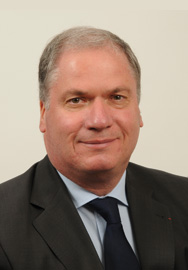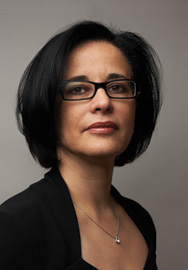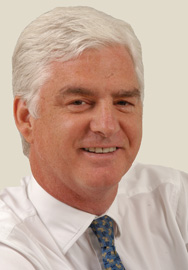|
Industry
De Beers Restates Goals
A recent DMIA general meeting featured De Beers executives who highlighted the firm’s evolving goals and consumer-centric restructuring.
By Ricci Dipshan

|

|

|
| Phillipe Mellier; Varda Shine; Stephen Lussier.
|
Tonight — we are back,” declared Philippe Mellier, chief executive officer (CEO) of De Beers Group, at the Diamond Manufacturers and Importers Association of America (DMIA)–hosted “An Evening with De Beers Group” presentation. In his first major New York appearance since becoming CEO, Mellier marked De Beers return in a big way. Along with De Beers Executive Vice President of Global Sightholder Sales Varda Shine and Executive Vice President of Marketing Stephen Lussier, Mellier used the January 8 event to reintroduce a changed company to the American diamond industry. De Beers must now be thought of as “something that goes way beyond being a mining company,” said Mellier, adding that “The industry today starts with the consumer, and we are being active to become a consumer-driven company.” This does not mean, however, that the company has stopped its exploration efforts. “We explore in many countries around the world to try and find the next big mine,” said Mellier. “In the past 20 years, no big mine has been found by anyone — we are looking for that next big one.” But he stressed that mining will not be the only focus and motivation for
De Beers operations. “We want to understand what consumers are looking for today and tomorrow,” he said. “We are no longer mining for the sake of mining.”
The De Beers CEO went on to declare that the industry and the company today must operate as a luxury market. “We are not a commodity, we are in the luxury world and
in the luxury world, you have to be consumer driven.”
While De Beers is no longer the monopolistic force it once was, with $6.5 billion in sales in 2011 alone, it is undoubtedly still a leader in the industry. Mellier said that De Beers is aware of this, but also understands that the company’s role in today’s industry has changed. “The fact that we are a leader gives us responsibility to lead the industry, but we don’t want to be arrogant,” he said, adding, “We don’t want to control the industry.”
Highlighting key parts of De Beers business, Shine explained that the diamond equity De Beers has is made up of “four components — financial value, ethical integrity, product integrity and emotional value.” In terms of diamond’s financial value, Shine effusively declared that “It’s a great business to be in.” Noting that while “the U.S. has been and still is
very much leading the market for diamond jewelry,” the growth of Chinese and Indian
markets, and the projected growth of each country’s middle class, will prove fertile
ground for increasing diamond demand. “We are really seeing an emergence of those
two developing economies.”
Increasing demand, Shine noted, will be met with steady supply, making diamonds
an even more sought-after, and lucrative, item on the global market. “When you look ahead, the demand is going to be growing at a pace that is accelerated. Supply, on the
other hand, will be steady. It is going to be around the same level — stagnating or slightly decreasing — as we go forward.”
Yet while this demand is growing, it could easily dry up if the industry does not
protect the ethical integrity of diamonds. In this respect, Shine said that De Beers is committed to giving back to the communities in which it operates. “Everything we do,
we do in conjunction with the countries we are in, so that they are benefiting.” She also touted the company’s “Best Practices Principles,” and said that “Every company we
work with adheres to these Best Practices Principles, and we keep on checking that
with third-party verification.”
Similarly, De Beers also aims to protect diamond’s product integrity. Making sure synthetic diamonds do not contaminate the natural diamond supply pipeline, Shine said,
is the idea behind the De Beers “3-D strategy — disclosures, detection, differentiation.” She added that De Beers plans to introduce a machine that will “screen melee stones sized
1 point and up for synthetics.” While De Beers has not yet devised a payment plan for the service, it did claim that the service will be available in the third quarter of 2013.
Discussing the fourth component of diamond equity, Lussier declared that diamonds
are unique because there is “no other luxury product that says love and emotion like a diamond does. It’s a universal symbol — it’s a luxury product, but it’s a necessary luxury.”
De Beers has always used this emotional component as a strategic element of its marketing plan. Though its marketing is not as pervasive as it once was, De Beers sees its advertising campaign for its new diamond brand Forevermark “as an effective new tool that will replace the strategic element we had from the generic marketing,” said Lussier.
Lussier explained that without De Beers widespread generic advertising — which
helped establish diamonds as symbols of love and commitment and led to the dominance
of diamond engagement rings — the industry can still promote the product on its own. However, he advised, companies need to “improve the emotional power of the marketing that already takes place. In the end, much of it doesn’t really hit the spot.”
With Forevermark and De Beers Jewellery, which is owned in part by luxury company LVMH, De Beers is looking to establish a retail presence in many markets around the globe, especially in Asia. “In America, we are the new baby on the block,” Lussier said, adding, “We are competitively stronger in the Far East — competitors have been there
for as long as we have.” Article from the Rapaport Magazine - February 2013. To subscribe click here.
|
|